最新中心静脉导管定义(精品收藏)
- 格式:doc
- 大小:21.00 KB
- 文档页数:11

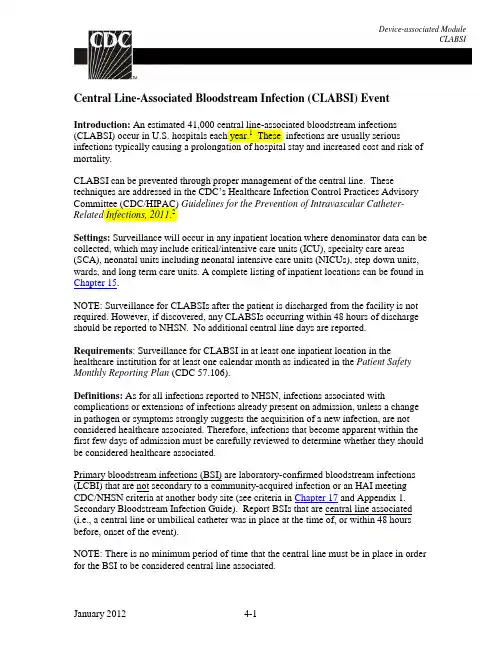
Central Line-Associated Bloodstream Infection (CLABSI) Event Introduction: An estimated 41,000 central line-associated bloodstream infections (CLABSI) occur in U.S. hospitals each year.1 These infections are usually serious infections typically causing a prolongation of hospital stay and increased cost and risk of mortality.CLABSI can be prevented through proper management of the central line. These techniques are addressed in the CDC’s Healthcare Infection Control Practices Advisory Committee (CDC/HIPAC) Guidelines for the Prevention of Intravascular Catheter-Related Infections, 2011.2Settings: Surveillance will occur in any inpatient location where denominator data can be collected, which may include critical/intensive care units (ICU), specialty care areas (SCA), neonatal units including neonatal intensive care units (NICUs), step down units, wards, and long term care units. A complete listing of inpatient locations can be found in Chapter 15.NOTE: Surveillance for CLABSIs after the patient is discharged from the facility is not required. However, if discovered, any CLABSIs occurring within 48 hours of discharge should be reported to NHSN. No additional central line days are reported. Requirements: Surveillance for CLABSI in at least one inpatient location in the healthcare institution for at least one calendar month as indicated in the Patient Safety Monthly Reporting Plan (CDC 57.106).Definitions: As for all infections reported to NHSN, infections associated with complications or extensions of infections already present on admission, unless a change in pathogen or symptoms strongly suggests the acquisition of a new infection, are not considered healthcare associated. Therefore, infections that become apparent within the first few days of admission must be carefully reviewed to determine whether they should be considered healthcare associated.Primary bloodstream infections (BSI) are laboratory-confirmed bloodstream infections (LCBI) that are not secondary to a community-acquired infection or an HAI meeting CDC/NHSN criteria at another body site (see criteria in Chapter 17 and Appendix 1. Secondary Bloodstream Infection Guide). Report BSIs that are central line associated (i.e., a central line or umbilical catheter was in place at the time of, or within 48 hours before, onset of the event).NOTE: There is no minimum period of time that the central line must be in place in order for the BSI to be considered central line associated.Location of attribution: The inpatient location where the patient was assigned on the date of the BSI event, which is further defined as the date when the first clinical evidence appeared or the date the specimen used to meet the BSI criteria was collected, whichever came first.EXAMPLE: Patient, who had no clinical signs or symptoms of sepsis upon arrival to the Emergency Department, has a central line inserted there before being admitted to the MICU has a central line inserted in the Emergency Department and then is admitted to the MICU. Within 24 hours of admission to the MICU, patient meets criteria for BSI. This is reported to NHSN as a CLABSI for the MICU because the Emergency Department is not an inpatient location and no denominator data are collected there. EXCEPTION:Transfer Rule: If a CLABSI develops within 48 hours of transfer from one inpatient location to another in the same facility, or a new facility, the infection is attributed to the transferring location. This is called the Transfer Rule and examples are shown below: •Patient with a central line in place in the SICU is transferred to the surgical ward.Thirty six (36) hours later, the patient meets the criteria for BSI. This is reported to NHSN as a CLABSI for the SICU.•Patient is transferred to the medical ward from the MSICU after having the central line removed. Within 24 hours, patient meets criteria for a BSI. This isreported to NHSN as a CLABSI for the MSICU.•Patient with a central line in place is transferred from the medical ward to the coronary care ICU (CCU). After 4 days in the CCU, the patient meets the criteria for a BSI. This is reported to NHSN as a CLABSI for the CCU.•Patient on the urology ward of Hospital A had the central line removed and is discharged home a few hours later. The IP from Hospital B calls the next day toreport that this patient has been admitted to Hospital B with a BSI. This CLABSI should be reported to NHSN for, and by, Hospital A and attributed to the urology ward. No additional catheter days are reported.Central line: An intravascular catheter that terminates at or close to the heart or in one of the great vessels which is used for infusion, withdrawal of blood, or hemodynamic monitoring. The following are considered great vessels for the purpose of reporting central-line BSI and counting central-line days in the NHSN system: Aorta, pulmonary artery, superior vena cava, inferior vena cava, brachiocephalic veins, internal jugular veins, subclavian veins, external iliac veins, common iliac veins, femoral veins, and in neonates, the umbilical artery/vein.NOTES:1.Neither the insertion site nor the type of device may be used to determine if a linequalifies as a central line. The device must terminate in one of these vessels or in or near the heart to qualify as a central line.2.An introducer is considered an intravascular catheter, and depending on thelocation of its tip, may be a central line.3. A Hemodialysis Reliable Outflow dialysis catheter (HERO), that is located in oneof the great vessels and used for purposes outlined above, is considered a centralline.4.Pacemaker wires and other nonlumened devices inserted into central bloodvessels or the heart are not considered central lines, because fluids are not infused, pushed, nor withdrawn through such devices.5.The following devices are not considered central lines: extracorporeal membraneoxygenation (ECMO), femoral arterial catheters and intraaortic balloon pump(IABP) devices. If you have a question about whether a device qualifies as acentral line, please email us at NHSN@.Infusion: The introduction of a solution through a blood vessel via a catheter lumen. This may include continuous infusions such as nutritional fluids or medications, or it may include intermittent infusions such as flushes or IV antimicrobial administration, or blood, in the case of transfusion or hemodialysis.Umbilical catheter: A central vascular device inserted through the umbilical artery or vein in a neonate.Temporary central line: A non-tunneled catheter.Permanent central line: Includeso Tunneled catheters, including certain dialysis catheterso Implanted catheters (including ports)Laboratory-confirmed bloodstream infection (LCBI): Must meet one of the following criteria:Criterion 1: Patient has a recognized pathogen cultured from one or more blood culturesandorganism cultured from blood is not related to an infection at another site. (See Notes 1 and 2 below and Appendix 1. Secondary Bloodstream Infection Guide.)Criterion 2: Patient has at least one of the following signs or symptoms: fever(>38o C), chills, or hypotensionandsigns and symptoms and positive laboratory results are not related to an infection at another site (See Appendix 1. Secondary Bloodstream Infection Guide.)andcommon commensal (i.e., diphtheroids [Corynebacterium spp. not C. diphtheriae], Bacillus spp. [not B. anthracis], Propionibacterium spp., coagulase-negative staphylococci [including S. epidermidis], viridans group streptococci, Aerococcus spp., and Micrococcus spp.) is cultured from two or more blood cultures drawn on separate occasions.Criterion 3: Patient < 1 year of age has at least one of the following signs or symptoms: fever (>38o C core) hypothermia (<36o C core), apnea, or bradycardiaandsigns and symptoms and positive laboratory results are not related to an infection at another site (See Appendix 1. Secondary Bloodstream Infection Guide.)andcommon skin commensal (i.e., diphtheroids [Corynebacterium spp. not C. diphtheriae], Bacillus spp. [not B. anthracis], Propionibacterium spp., coagulase-negative staphylococci [including S. epidermidis], viridans group streptococci, Aerococcus spp., Micrococcus spp.) is cultured from two or more blood cultures drawn on separate occasions. (See Notes 3, 4 and 5 below.)NOTES:1.In criterion 1, the phrase “one or more blood cultures” means that at least onebottle from a blood draw is reported by the laboratory as having grown organisms(i.e., is a positive blood culture).2.In criterion 1, the term “recognized pathogen” does not include organismsconsidered common commensals (see criteria 2 and 3 for a list of commoncommensals). A few of the recognized pathogens are S. aureus, Enterococcusspp., E. coli, Pseudomonas spp., Klebsiella spp., Candida spp., etc.3.In criteria 2 and 3, the phrase “two or more blood cultures drawn on separateoccasions” means 1) that blood from at least two blood draws were collectedwithin two days of each other (e.g., blood draws on Monday and Tuesday orMonday and Wednesday would be acceptable for blood cultures drawn onseparate occasions, but blood draws on Monday and Thursday would be too farapart in time to meet this criterion), and 2) that at least one bottle from each blood draw is reported by the laboratory as having grown the same common commensal(i.e., is a positive blood culture). (See Note 4 for determining sameness oforganisms.)a.For example, an adult patient has blood drawn at 8 a.m. and again at 8:15 a.m.of the same day. Blood from each blood draw is inoculated into two bottlesand incubated (four bottles total). If one bottle from each blood draw set ispositive for coagulase-negative staphylococci, this part of the criterion is met.b.For example, a neonate has blood drawn for culture on Tuesday and again onSaturday and both grow the same common commensal. Because the timebetween these blood cultures exceeds the two-day period for blood drawsstipulated in criteria 2 and 3, this part of the criteria is not met.c. A blood culture may consist of a single bottle for a pediatric blood draw dueto volume constraints. Therefore, to meet this part of the criterion, each bottlefrom two or more draws would have to be culture-positive for the samecommensal.4.If the common commensal is identified to the species level from one culture, anda companion culture is identified with only a descriptive name (e.g., to the genuslevel), then it is assumed that the organisms are the same. The organismidentified to the species level should be reported as the infecting pathogen alongwith its antibiogram if available (see Table 1 below).Table 1. Examples of how to report speciated and unspeciated common commensals Culture Report CompanionReport as…Culture ReportS. epidermidisS. epidermidis Coagulase-negativestaphylococciBacillus spp. (not anthracis) B. cereus B. cereusS. salivarius Strep viridans S. salivarius5.Only genus and species identification should be utilized to determine thesameness of organisms. No additional comparative methods should be used (e.g., morphology or antibiograms) because laboratory testing capabilities and protocols may vary between facilities. This will reduce reporting variability, solely due tolaboratory practice, between facilities reporting LCBIs meeting criterion 2.Report the organism to the genus/species level only once, and if antibiogram data are available, report the results from the most resistant panel.6.LCBI criteria 1 and 2 may be used for patients of any age, including patients < 1year of age.7.Specimen Collection Considerations:Ideally, blood specimens for culture should be obtained from two to four blooddraws from separate venipuncture sites (e.g., right and left antecubital veins), not through a vascular catheter. These blood draws should be performedsimultaneously or over a short period of time (i.e., within a few hours).3,4 If your facility does not currently obtain specimens using this technique, you must stillreport BSIs using the criteria and notes above, but you should work withappropriate personnel to facilitate better specimen collection practices for bloodcultures.REPORTING INSTRUCTIONS:•Report organisms cultured from blood as BSI – LCBI when no other site of infection is evident.•When there is a positive blood culture and clinical signs or symptoms of localized infection at a vascular access site, but no other infection can be found, the infection is considered a primary BSI.•Purulent phlebitis confirmed with a positive semiquantitative culture of a catheter tip, but with either negative or no blood culture is considered a CVS-VASC, not a BSI or an SST-SKIN or ST infection.•Occasionally a patient with both peripheral and central IV lines develops a primary bloodstream infection (LCBI) that can clearly be attributed to the peripheral line (e.g., pus at the insertion site and matching pathogen from pus and blood). In this situation, enter “Central Line = No” in the NHSN application. You should, however, include the patient’s central line days in the summary denominator count.Numerator Data: The Primary Bloodstream Infection (BSI) form (CDC 57.108) is used to collect and report each CLABSI that is identified during the month selected for surveillance. The Instructions for Completion of Primary Bloodstream Infection Form (Tables of Instructions, Tables 2 and 2a.) contains brief instructions for collection and entry of each data element on the form. The Primary BSI form includes patient demographic information and whether a central line was present, and, if so, the type of central line the patient had if appropriate to the location; these data will be used to calculate line-specific infection rates. Additional data include the specific criteria met for identifying the primary BSI, whether the patient died, the organisms isolated from blood cultures, and the organisms’ antimicrobial susceptibilities.REPORTING INSTRUCTION:•If no CLABSIs are identified during the month of surveillance, the Report No Events box must be checked on the appropriate denominator summary screen,e.g., Denominators for Intensive Care Unit (ICU)/Other locations (Not NICU orSCA), etc.Denominator Data: Device days and patient days are used for denominators (see Chapter 16, Key Terms). Device-day denominator data that are collected differ according to the location of the patients being monitored; however, they should be collected at the same time each day. When denominator data are available from electronic databases, these sources may be used as long as the counts are not substantially different (+/- 5%) from manually-collected counts, validated for a minimum of 3 months.For locations other than specialty care areas (SCAs) and NICUs, the number of patients with one or more central lines of any type is collected daily, at the same time each day, during the month and recorded on the Denominators for Intensive Care Unit (ICU)/Other Locations (Not NICU or Specialty Care Area (SCA)) (CDC 57.118). Only the totals for the month are entered into NHSN. When denominator data are available from electronic sources (e.g., central line days from electronic charting), these sources may be used as long as the counts are not substantially different (+/- 5%) from manually-collected counts, validated for a minimum of 3 months.For specialty care areas, the number of patients with one or more central lines is dichotomized into those with permanent central lines and those with temporary central lines on the Denominators for Specialty Care Area (CDC 57.117) form. Each is collected daily, at the same time each day. Only the total for the month are entered into NHSN. This distinction in lines is made because permanent lines are commonly used in patients frequenting these areas and may have lower rates of associated infection than central lines inserted for temporary use. If a patient has both a temporary and a permanent central line, count the day only as a temporary line day. The Instructions for Completion of Denominators for Intensive Care Unit (ICU)/Other Locations Form (Tables of Instructions, Table 6) and Instructions for Completion of Denominators for Specialty Care Areas (SCA)Form (Tables of Instructions, Table 7) contain brief instructions for collection and entry of each data element on the forms.In NICUs, the number of patients with central lines is stratified by birthweight in five categories since risk of BSI varies by birthweight. These data are collected on the Denominators for Neonatal Intensive Care Unit (NICU) (CDC 57.116) form.NOTE: The weight of the infant at the time of BSI is not used and should not be reported. For example, if a neonate weighs 1006 grams at birth but remains in the NICU for two months and has a body weight of 1650 grams when it develops a CLABSI, record the birthweight of 1006 grams on the BSI form. The Instructions for Completion of Denominators for Neonatal Intensive Care Unit (NICU) form (Tables of Instructions, Table 8) contains brief instructions for collection and entry of each data element on the forms.Data Analyses: The SIR is calculated by dividing the number of observed infections by the number of expected infections. The number of expected infections, in the context of statistical prediction, is calculated using CLABSI rates from a standard population during a baseline time period as reported in the NHSN Report.NOTE: The SIR will be calculated only if the number of expected HAIs (numExp) is ≥ 1.While the CLABSI SIR can be calculated for single locations, the measure also allows you to summarize your data across multiple locations, adjusting for differences in the incidence of infection among the location types. For example, you will be able to obtain one CLABSI SIR adjusting for all locations reported. Similarly, you can obtain one CLABSI SIR for all specialty care areas in your facility.The CLABSI rate per 1000 central line days is calculated by dividing the number of CLABSI by the number of central line days and multiplying the result by 1000. TheCentral Line Utilization Ratio is calculated by dividing the number of central line days by the number of patient days. These calculations will be performed separately for different types of ICUs, specialty care areas, and other locations in the institution. Separate rates and ratios will also be calculated for different types of catheters in specialty care areas and for birthweight categories in NICUs.1CDC Vital Signs. Making healthcare safer: reducing bloodstream infections. March 2011. Available at: /VitalSigns/HAI/index.html.2 O’Grady NP, Alexander M, Burns LA,, Dellinger EP, Garland J, Heard SO, Maki DG, et al. Guidelines for the prevention of intravascular catheter-related infections, 2011. Clinical Infectious Diseases 2011; 52(a):1087-99.3 Clinical and Laboratory Standards Institute (CLSI). Principles and Procedures for Blood Cultures; Approved Guideline. CLSI document M47-A (ISBN 1-56238-641-7). Clinical and Laboratory Standards Institute, 940 West Valley Road, Suite 1400, Wayne, Pennsylvania, USA, 2007.4 Baron EJ, Weinstein MP, Dunne Jr WM, Yagupsky P, Welch DF, and Wilson DM. Blood Cultures IV. ASM Press: Washington, DC; 2005.Appendix 1. Secondary Bloodstream Infection (BSI) GuideWhat is the meaning of the statement “not related to infection at another site” in relation to a positive blood culture?The purpose of using the CDC/NHSN infection criteria is to identify and consistently categorize infections that are healthcare-associated into major and specific infection sites or types. Several of the criteria include the caveat that signs, symptoms, and/or laboratory findings may not be related to infection at another site. When assessing positive blood cultures in particular, one must be sure that there is no other CDC-defined primary site of HAI that may have seeded the bloodstream secondarily; otherwise the bloodstream infection may be misclassified as a primary BSI or erroneously associated with the use of a central line, i.e., called a CLABSI.If the criteria for the primary infection site require a culture, then at least one organism cultured from that site must match an organism in the blood culture. NOTE: As of 1/1/11, antibiograms of the blood and site isolates do not have to match. In these instances and others where a culture of the involved site is not required for the criteria, and no such culture is collected, it is necessary to use clinical judgment regarding the likelihood of the organisms causing a secondary bloodstream infection. The graphic below may be used to help determine the relatedness of a primary site of infection to a positive blood culture. In addition, if the blood isolate by itself does not meet BSI criteria (e.g., only one positive blood culture of a common commensal), then that isolate may not be used to indicate the presence of a secondary BSI. For example, the patient has an HAI meeting criteria for symptomatic urinary tract infection due to E. coli and a single positive blood culture with E. coli and S. epidermidis, the SUTI should be reported as having a secondary bloodstream infection, but only E. coli should be listed as the infecting pathogen.。
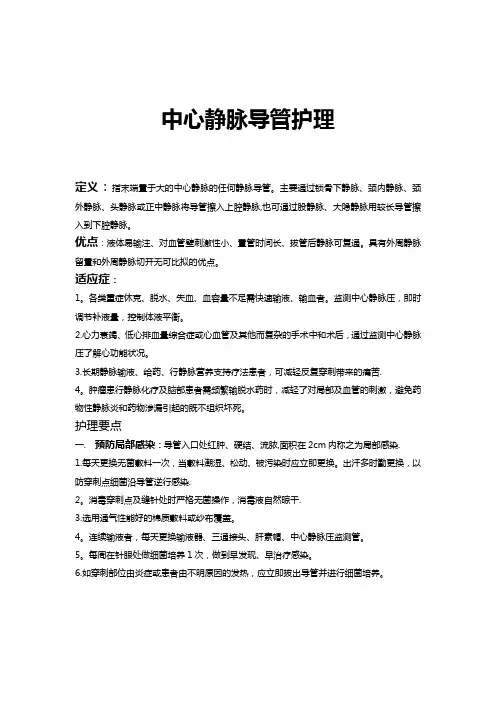
中心静脉导管护理定义:指末端置于大的中心静脉的任何静脉导管。
主要通过锁骨下静脉、颈内静脉、颈外静脉、头静脉或正中静脉将导管擦入上腔静脉,也可通过股静脉、大隐静脉用较长导管擦入到下腔静脉。
优点:液体易输注、对血管壁刺激性小、置管时间长、拔管后静脉可复通。
具有外周静脉留置和外周静脉切开无可比拟的优点。
适应症:1。
各类重症休克、脱水、失血、血容量不足需快速输液、输血者。
监测中心静脉压,即时调节补液量,控制体液平衡。
2.心力衰竭、低心排血量综合症或心血管及其他而复杂的手术中和术后,通过监测中心静脉压了解心功能状况。
3.长期静脉输液、给药、行静脉营养支持疗法患者,可减轻反复穿刺带来的痛苦.4。
肿瘤患行静脉化疗及脑部患者需频繁输脱水药时,减轻了对局部及血管的刺激,避免药物性静脉炎和药物渗漏引起的既不组织坏死。
护理要点一.预防局部感染:导管入口处红肿、硬结、流脓,面积在2cm内称之为局部感染.1.每天更换无菌敷料一次,当敷料潮湿、松动、被污染时应立即更换。
出汗多时勤更换,以防穿刺点细菌沿导管逆行感染.2。
消毒穿刺点及缝针处时严格无菌操作,消毒液自然晾干.3.选用通气性能好的棉质敷料或纱布覆盖。
4。
连续输液者,每天更换输液器、三通接头、肝素帽、中心静脉压监测管。
5。
每周在针眼处做细菌培养1次,做到早发现、早治疗感染。
6.如穿刺部位由炎症或患者由不明原因的发热,应立即拔出导管并进行细菌培养。
二。
保持管道通畅1。
在输注酸、碱性药物之间应用生理盐水冲管。
2。
先输乳剂,再输非乳剂。
3。
输注刺激性及粘附性强的药物前后应用生理盐水冲管。
4.熟练掌握三通管的操作,以免血液回流引起导管堵塞.5.如患者能起床,要注意抬高输液瓶。
6.一般不通过导管留取血标本,以免影响化验数据准确性及引起导管堵塞,如从导管留取标本,抽血后必须用肝素盐水冲洗导管。
7。
暂停输液时,需用肝素盐水封管,其浓度至少为10u/ml,每次用量5ml.也可用生理盐水封管。
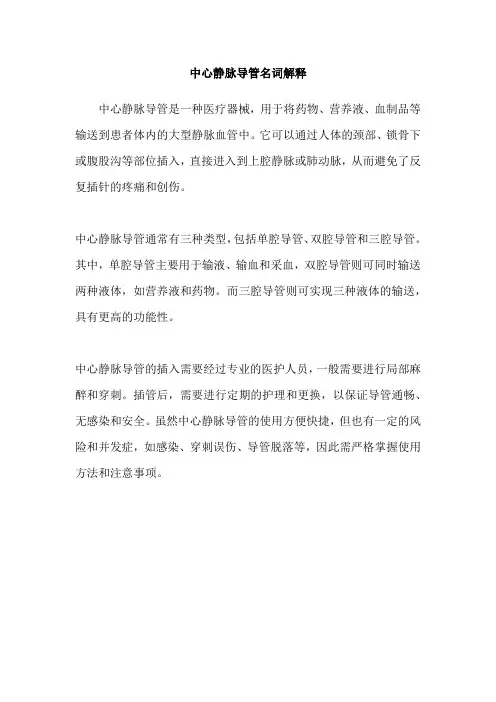
中心静脉导管名词解释
中心静脉导管是一种医疗器械,用于将药物、营养液、血制品等输送到患者体内的大型静脉血管中。
它可以通过人体的颈部、锁骨下或腹股沟等部位插入,直接进入到上腔静脉或肺动脉,从而避免了反复插针的疼痛和创伤。
中心静脉导管通常有三种类型,包括单腔导管、双腔导管和三腔导管。
其中,单腔导管主要用于输液、输血和采血,双腔导管则可同时输送两种液体,如营养液和药物。
而三腔导管则可实现三种液体的输送,具有更高的功能性。
中心静脉导管的插入需要经过专业的医护人员,一般需要进行局部麻醉和穿刺。
插管后,需要进行定期的护理和更换,以保证导管通畅、无感染和安全。
虽然中心静脉导管的使用方便快捷,但也有一定的风险和并发症,如感染、穿刺误伤、导管脱落等,因此需严格掌握使用方法和注意事项。

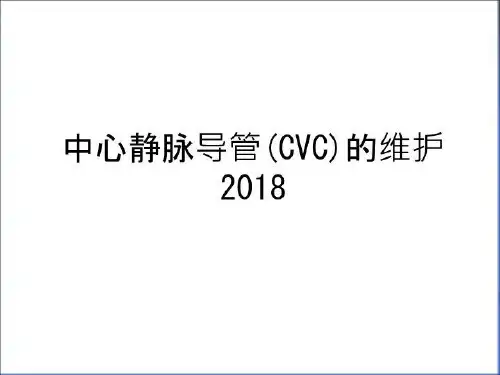

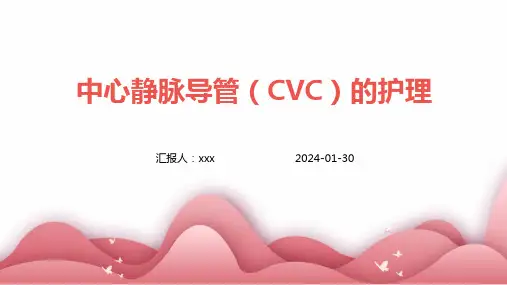
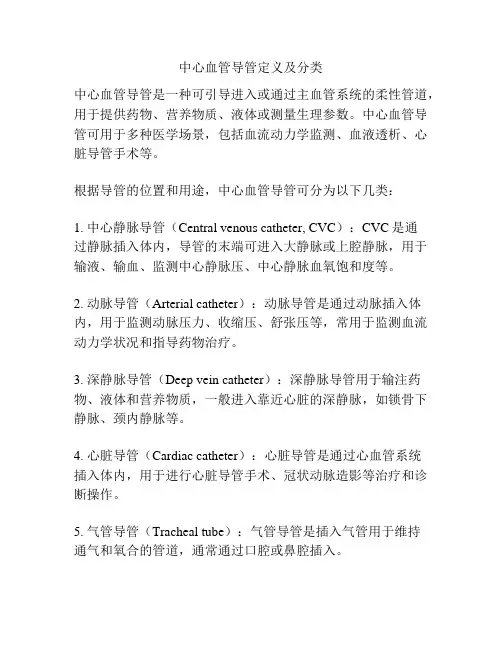
中心血管导管定义及分类
中心血管导管是一种可引导进入或通过主血管系统的柔性管道,用于提供药物、营养物质、液体或测量生理参数。
中心血管导管可用于多种医学场景,包括血流动力学监测、血液透析、心脏导管手术等。
根据导管的位置和用途,中心血管导管可分为以下几类:
1. 中心静脉导管(Central venous catheter, CVC):CVC是通
过静脉插入体内,导管的末端可进入大静脉或上腔静脉,用于输液、输血、监测中心静脉压、中心静脉血氧饱和度等。
2. 动脉导管(Arterial catheter):动脉导管是通过动脉插入体内,用于监测动脉压力、收缩压、舒张压等,常用于监测血流动力学状况和指导药物治疗。
3. 深静脉导管(Deep vein catheter):深静脉导管用于输注药物、液体和营养物质,一般进入靠近心脏的深静脉,如锁骨下静脉、颈内静脉等。
4. 心脏导管(Cardiac catheter):心脏导管是通过心血管系统
插入体内,用于进行心脏导管手术、冠状动脉造影等治疗和诊断操作。
5. 气管导管(Tracheal tube):气管导管是插入气管用于维持
通气和氧合的管道,通常通过口腔或鼻腔插入。
这些中心血管导管的选择和应用需根据患者的具体情况和医疗需要来决定,医护人员需在操作时严格遵循无菌操作规范,以避免并发症的发生。
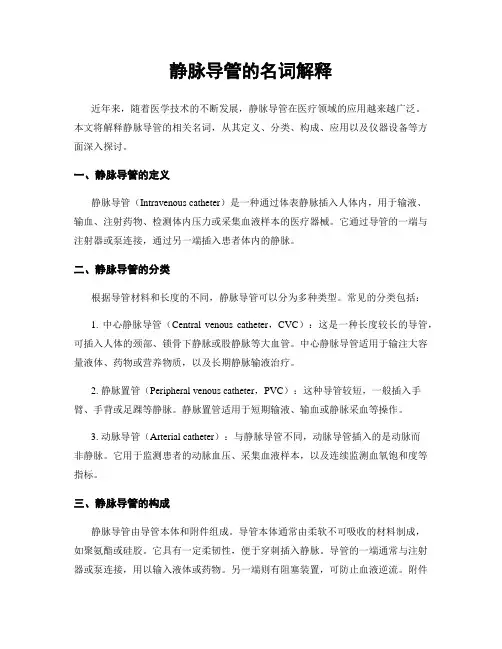
静脉导管的名词解释近年来,随着医学技术的不断发展,静脉导管在医疗领域的应用越来越广泛。
本文将解释静脉导管的相关名词,从其定义、分类、构成、应用以及仪器设备等方面深入探讨。
一、静脉导管的定义静脉导管(Intravenous catheter)是一种通过体表静脉插入人体内,用于输液、输血、注射药物、检测体内压力或采集血液样本的医疗器械。
它通过导管的一端与注射器或泵连接,通过另一端插入患者体内的静脉。
二、静脉导管的分类根据导管材料和长度的不同,静脉导管可以分为多种类型。
常见的分类包括:1. 中心静脉导管(Central venous catheter,CVC):这是一种长度较长的导管,可插入人体的颈部、锁骨下静脉或股静脉等大血管。
中心静脉导管适用于输注大容量液体、药物或营养物质,以及长期静脉输液治疗。
2. 静脉置管(Peripheral venous catheter,PVC):这种导管较短,一般插入手臂、手背或足踝等静脉。
静脉置管适用于短期输液、输血或静脉采血等操作。
3. 动脉导管(Arterial catheter):与静脉导管不同,动脉导管插入的是动脉而非静脉。
它用于监测患者的动脉血压、采集血液样本,以及连续监测血氧饱和度等指标。
三、静脉导管的构成静脉导管由导管本体和附件组成。
导管本体通常由柔软不可吸收的材料制成,如聚氨酯或硅胶。
它具有一定柔韧性,便于穿刺插入静脉。
导管的一端通常与注射器或泵连接,用以输入液体或药物。
另一端则有阻塞装置,可防止血液逆流。
附件包括导管固定带、注射装置、阻塞装置等,它们在操作中起到固定导管、输液或采血等功能。
四、静脉导管的应用静脉导管广泛应用于临床医学中的各个领域,主要包括输液、输血、注射药物、监测体内压力、采血和血液灌流等操作。
静脉导管能够在短时间内将液体或药物输送到患者体内,提高治疗效果,减轻病人的不适感。
同时,通过导管可以进行血液采集、监测体内压力以及进行血液灌流等操作,为临床医师提供了诊断、治疗和预防的便利。
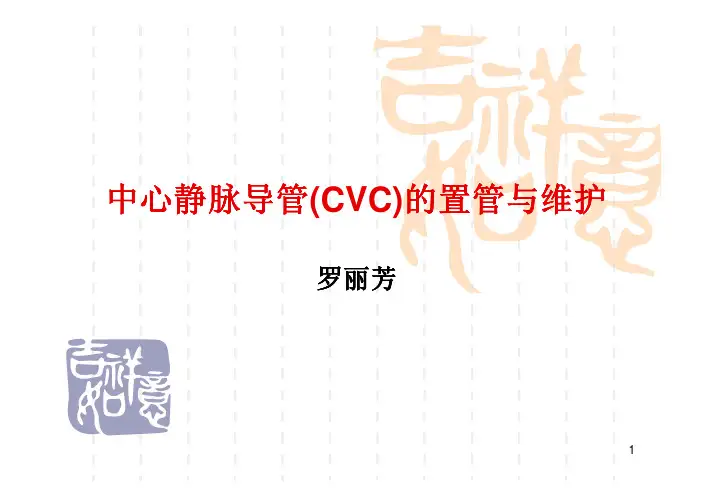
1中心静脉导管经锁骨下静脉、颈内静脉、股静脉置管置管,尖端位于上腔静脉或下腔静脉的导管.2.导管相关性血流感染带有血管内导管或者拔除血管内导管48小时内的患者出现菌血症或真菌血症,并伴有发热(>38℃)、寒颤或低血压等感染表现,除血管导管外没有其他明确的感染源。
实验室微生物学检查显示:外周静脉血培养细菌或真菌阳性;或者从导管段和外周血培养出相同种类、相同药敏结果的致病菌。
3.护理分级:患者在住院期间,医护人员根据患者病情和(或)自理能力进行评定而确定的护理级别。
4.自理能力.在生活中个体照料自己的行为能力5.Barthel指数:对患者日常生活活动的功能状态进行测量,个体得分取决于对一系列独立行为的测量,总分范围在0—100。
6.药物渗出。
静脉输液过程中,非腐蚀性药液进入静脉管腔以外的周围组织.药物外渗.静脉输液过程中,腐蚀性药液进入静脉管腔以外的周围组织。
7。
静脉治疗将各种药物(包括血液制品)以及血液,通过静脉注入血液循环的治疗方法,包括静脉注射、静脉输液和静脉输血;8.无菌技术。
在执行医疗、护理操作过程中,防止一切微生物侵入机体,保持无菌物品及无菌区域不被污染的技术.9、药物外溢.在药物配置及使用过程中,药物意外溢出暴露于环境中,如皮肤表面、台面、地面等。
10输液港.完全植入人体内的闭合输液装置,包括尖端位于上腔静脉的导管部分及埋植于皮下的注射座。
11、日常生活活动。
人们为了维持生存及适应生存环境而每天反复进行的、最基本的、具有共性的活动。
12、PICC::经外周静脉置入中心静脉导管经上肢贵要静脉、肘正中静脉、头静脉、肱静脉,颈外静脉(新生儿还可通过下肢大隐静脉、头部颞静脉、耳后静脉等)穿刺置管,尖端位于上腔静脉或下腔静脉的导管。
1PICC穿刺时应注意以下事项:a)ﻩ接受乳房根治术或腋下淋巴结清扫的术侧肢体、锁骨下淋巴结肿大或有肿块侧、安装起搏器侧不宜进行同侧置管,患有上腔静脉压迫综合征的患者不宜进行置管;b)宜选择肘部或上臂静脉作为穿刺部位,避开肘窝、感染及有损伤的部位;新生儿还可选择下肢静脉、头部静脉和颈部静脉;c)ﻩ有血栓史、血管手术史的静脉不应进行置管;放疗部位不宜进行置管。
2、Barthel指数评定细则包括哪10项内容?进食.洗澡.修饰.穿衣。
控制大便.控制小便.如厕.床椅转移.平地行走.上下楼梯3、抢救患者时,如何执行口头医嘱?抢救患者时,医师下达的口头医嘱,执行者需完整复述一遍,经医师复核无误后方可执行,并保留用过的空安瓿,经两人核对后方可弃去。
抢救结束后及时补全医嘱,执行者签全名,执行时间为抢救当时时间。
4、简述护理分级方法患者人院后应根据患者病情严重程度确定病情等级.根据患者Barthel 指数总分确定自理能力的等级(表1 )。
依据病情等级和(或)自理能力等级,确定患者护理分级。
临床医护人员应根据患者的病情和自理能力的变化动态调整患者护理分级。
5、医嘱查对制度?1、处理医嘱,应做到班班查对.2、处理医嘱及查对者,均须签全名。
3、临时医嘱执行后,要记录执行时间并签全名。
4、长期医嘱执行后,要在执行单上签名并保留执行单。
5、对有疑问的医嘱,必须向医师核对无误后方可执行。
6、抢救患者时,医师下达的口头医嘱,执行者需完整复述一遍,经医师复核无误后方可执行,并保留用过的空安瓿,经两人核对后方可弃去.抢救结束后及时补全医嘱,执行者签全名,执行时间为抢救当时时间。
6、危重患者院内检查或转运时,要做好哪些工作?(一)充分评估患者,备齐相应药品及物品,做好人力准备,有效应对意外发生。
(二)根据患者病情选择合适的搬运方式,保持患者体位舒适,做好保暖。
(三)途中保持呼吸道通畅,密切观察病情变化,发现问题及时处理.(四)保持输液及各种管道的通畅,妥善固定,防止脱出、扭曲、返流。
(五)在转运过程中,应与患者进行有效的沟通。
(六)与接收科室医护人员认真交接患者病情、注意事项等,填写转科患者交接记录单。
7、护理交班内容(一)患者总数、出入院、转科、转院、分娩、手术、死亡人数以及新入院、危重患者、抢救患者、大手术后或有特殊检查处理、病情变化及思想情绪波动的患者。
(二)医嘱执行情况、各项护理记录、各种检查标本采集、各种处置完成情况及后续工作。
(三)查看昏迷、瘫痪等危重患者皮肤情况,基础护理完成情况,各种导管固定和通畅情况。
(四)备用、贵重、麻醉药品、精神药品、放射性药品、医疗用毒性药品及药品类易制毒化学品(毒麻、精神药品)及抢救药品的数量,器械、仪器的数量、功能状态等。
(五)交接班者共同巡视检查病房是否达到清洁、整齐、安静的要求,查看各项工作的落实情况.8、输液反应的处理原则?发生输液反应时,应停止输液,更换药液及输液器,通知医师,给予对症处理,并保留原有药液及输液器。
应密切观察病情变化并记录。
9、一级护理的护理要点:(1)每小时巡视患者,观察患者病情变化(2)根据患者病情,测量生命体征;(3)根据医嘱,正确实施治疗、给药措施;(4)根据患者病情和自理能力,正确实施基础护理和专科护理,如口腔护理、压疮护理、气道护理及管路护理等,实施安全措施;(5)提供护理相关的健康指导.一级护理分级依据?a )病情趋向稳定的重症患者; b )病情不稳定或随时可能发生变化的患者; c )手术后或者治疗期间需要严格卧床的患者; d )自理能力重度依赖的患者。
10、输血查对制度一、输血前须两人核对,确保医嘱单、输血记录单、血型单、血袋标签上的信息完全一致.严格执行“三查八对”:三查:查血液有效期、血液质量(血液有无凝血块和溶血、血袋有无破损)、输血装置是否完好.八对:对床号、姓名、住院号、血袋号、血剂量、血液种类、血型及交叉配血的各项内容。
二、两人核对无误后于输血记录单上签字。
三、床边再次由两名护士进行“三查八对”,核对患者床头牌及腕带,让患者或其家属陈述患者姓名及血型,确认无误后方可输入。
11、静脉炎的处理原则有哪些?应拔除PVC,可暂时保留PICC;及时通知医师,给予对症处理. 将患肢抬高、制动,避免受压。
必要时,应停止在患肢静脉输液。
应观察局部及全身情况的变化并记录。
12、密闭式输血操作程序及 1. 输血前应了解患者血型、输血史及不良反应史.2. 输血前和床旁输血时应分别双人核对输血信息,无误后才可输注,3 输血起始速度宜慢,应观察15min无不适后再根据患者病情、年龄及输注血制品的成分调节滴速.4. 血制品不应加热,不应随意加入其它药物.5。
全血、成分血及其它血液制品应从血库取出后30min内输注,1个单位的全血或成分血应在4h内输完。
6。
输血过程中应对患者进行监测.7 输血完毕应记录,空血袋应低温保存24h.输血反应处理发生输血反应立即减慢或停止输血,更换输血器,用生理盐水维持静脉通畅,通知医生给予对症处理,保留余血及输血器,并上报输血科。
应密切观察病情变化并记录。
13自理能力等级和划分标准需要照顾程度自理能力等级等级划分标准ﻩ需要照护程度重度依赖ﻩ总分≤40分ﻩ全部需要他人照护中度依赖总分41~60分大部分需他人照护轻度依赖总分61~99分ﻩ少部分需他人照护无需依赖总分100分无需他人照护15、静脉治疗操作基本原则1。
所有操作应执行查对制度并对患者进行两种以上的身份识别,询问过敏史。
2 穿刺针、导管、注射器、输液(血)器、及输液附加装置等应一人一用一灭菌,一次性使用的医疗器具不应重复使用。
3 易发生血源性病原体职业暴露的高危病区宜选用一次性安全型注射和输液装置.4 静脉注射、静脉输液、静脉输血及静脉导管穿刺和维护应遵循无菌技术操作原则..5操作前后应执行WS/T 313规定,不应以戴手套取代手卫生。
6 置入PVC时宜使用清洁手套,置入PICC时宜遵守最大无菌屏障原则。
7 PICC穿刺以及PICC、CVC、PORT维护时,宜使用专用护理包。
.8 穿刺及维护时应选择合格的皮肤消毒剂,宜选用2%葡萄糖酸氯己定乙醇溶液(年龄<2个月的婴儿慎用)、有效碘浓度不低于0。
5%的碘伏或2%碘酊溶液和75%酒精。
9 消毒时应以穿刺点为中心用力擦拭,至少消毒两遍或遵循消毒剂使用说明书,待自然干燥后方可穿刺。
10 置管部位不应使用丙酮、乙醚等有机溶剂,不宜在穿刺部位使用抗菌油膏.16、饮食查对制度每日处理医嘱后,1按护理单查对床头饮食卡、一览牌饮食标记。
2、发放特殊饮食时,应准确核对患者身份,让患者或其家属陈述患者姓名,以确认为正确的患者发放特殊饮食.3、患者进食时,查对饮食种类与患者的医嘱及病情是否相符.18特级护理的护理要点是什么(1)严密观察患者病情变化,监测生命体征;(2)根据医嘱,正确实施治疗、给药措施;(3)根据医嘱,准确测量出入量;(4)根据患者病情和自理能力,正确实施基础护理和专科护理,如口腔护理、压疮护理、气道护理及管路护理等,实施安全措施;(5)保持患者的舒适和功能体位;(6)实施床旁交接班.19、护理人员四勤是指:眼勤、手勤、腿勤、嘴勤20、简述导管相关性静脉血栓形成的处理原则?1可疑导管相关性静脉血栓形成时,应抬高患肢并制动,不应热敷、按摩、压迫,立即通知医师对症处理并记录。
2 应观察置管侧肢体、肩部、颈部及胸部肿胀、疼痛、皮肤温度及颜色、出血倾向及功能活动情况。
21、可疑导管相关性血流感染时如何处置?可疑导管相关性血流感染时,应立即停止输液,拔除PVC,暂时保留PICC、CVC、PORT,遵医嘱给予抽取血培养等处理并记录。
22、服药注射处置查对制度一、服药、注射、处置必须严格执行“三查九对”制度,操作前核对时让患者或其家属陈述患者姓名,或使用PDA电子扫描。
至少同时使用两种患者身份识别方法(如床号、姓名、住院号、出生年月等),以确认患者身份,禁止仅以房间号或床号作为识别的唯一依据.对新生儿及因意识不清、语言交流障碍等无法向医务人员陈述自己姓名的患者,有陪同人员时由陪同人员陈述患者姓名.三查:操作前查、操作中查、操作后查.九对:对床号、姓名、药名、剂量、用药时间、用法、浓度、有效期、过敏史。
二、清点药品时和使用药品前要检查药品外观、标签、有效期和批号,如不中心静脉导管定义符合要求不得使用。
静脉给药要注意有无变质、瓶口松动、裂缝。
同时使用多种药物时,要注意配伍禁忌。
水剂、片剂注意有无变质。
三、摆药后需经第二人核对无误后方可执行。
四、易致过敏药物,给药前应询问有无过敏史,使用麻醉药品、精神药品、放射性药品、医疗用毒性药品及药品类易制毒化学品等特殊管理药品的使用需经过双人核对,用后保留空瓶。
11 / 11... 感谢聆听...。